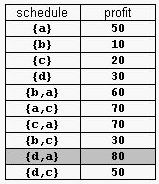Supermarket
| Time Limit: 2000MS | Memory Limit: 65536K | |
| Total Submissions: 9560 | Accepted: 4116 |
Description
A supermarket has a set Prod of products on sale. It earns a profit px for each product x∈Prod sold by a deadline dx that is measured as an integral number of time units starting from the moment the sale begins. Each product takes precisely one unit of time for being sold. A selling schedule is an ordered subset of products Sell ≤ Prod such that the selling of each product x∈Sell, according to the ordering of Sell, completes before the deadline dx or just when dx expires. The profit of the selling schedule is Profit(Sell)=Σ
x∈Sellpx. An optimal selling schedule is a schedule with a maximum profit.
For example, consider the products Prod={a,b,c,d} with (pa,da)=(50,2), (pb,db)=(10,1), (pc,dc)=(20,2), and (pd,dd)=(30,1). The possible selling schedules are listed in table 1. For instance, the schedule Sell={d,a} shows that the selling of product d starts at time 0 and ends at time 1, while the selling of product a starts at time 1 and ends at time 2. Each of these products is sold by its deadline. Sell is the optimal schedule and its profit is 80.

Write a program that reads sets of products from an input text file and computes the profit of an optimal selling schedule for each set of products.
For example, consider the products Prod={a,b,c,d} with (pa,da)=(50,2), (pb,db)=(10,1), (pc,dc)=(20,2), and (pd,dd)=(30,1). The possible selling schedules are listed in table 1. For instance, the schedule Sell={d,a} shows that the selling of product d starts at time 0 and ends at time 1, while the selling of product a starts at time 1 and ends at time 2. Each of these products is sold by its deadline. Sell is the optimal schedule and its profit is 80.

Write a program that reads sets of products from an input text file and computes the profit of an optimal selling schedule for each set of products.
Input
A set of products starts with an integer 0 <= n <= 10000, which is the number of products in the set, and continues with n pairs pi di of integers, 1 <= pi <= 10000 and 1 <= di <= 10000, that designate the profit and the selling deadline of the i-th product. White spaces can occur freely in input. Input data terminate with an end of file and are guaranteed correct.
Output
For each set of products, the program prints on the standard output the profit of an optimal selling schedule for the set. Each result is printed from the beginning of a separate line.
Sample Input
4 50 2 10 1 20 2 30 1 7 20 1 2 1 10 3 100 2 8 2 5 20 50 10
Sample Output
80 185
Hint
The sample input contains two product sets. The first set encodes the products from table 1. The second set is for 7 products. The profit of an optimal schedule for these products is 185.
Source
贪心+并查集的应用~
首先贪心的来看,按照获利来排序,把每一个放在他能够放的最后一个位置。
那么怎么快速确定他能放置的最后一个位置?
用并查集~
如果i这一天被使用了,fa=Getfather(i)那么f[fa]=f[fa-1],f[i]表示f[i]+1到i都被使用了。
如果fa=0说明这个物品不能加入。
#include <iostream>
#include <algorithm>
#include <cstring>
#include <cstdio>
#include <cstdlib>
#define M 10000+5
using namespace std;
int n,f[M];
struct data
{
int p,d;
}a[M];
void read(int &tmp)
{
tmp=0;
char ch=getchar();
int fu=1;
for (;ch<'0'||ch>'9';ch=getchar())
if (ch=='-') fu=-1;
for (;ch>='0'&&ch<='9';ch=getchar())
tmp=tmp*10+ch-'0';
tmp*=fu;
}
bool cmp(data a,data b)
{
if (a.p==b.p) return a.d<b.d;
return a.p>b.p;
}
int Getfather(int x)
{
return x==f[x]?x:f[x]=Getfather(f[x]);
}
int main()
{
while (scanf("%d",&n)!=EOF)
{
int mad=0;
for (int i=1;i<=n;i++)
read(a[i].p),read(a[i].d),mad=max(mad,a[i].d);
sort(a+1,a+1+n,cmp);
int ans=0;
for (int i=0;i<=mad;i++)
f[i]=i;
for (int i=1;i<=n;i++)
{
int fa=Getfather(a[i].d);
if (fa)
{
ans+=a[i].p;
f[fa]=f[fa-1];
}
}
printf("%d\n",ans);
}
return 0;
}

感悟:
1.WA是因为f[fa]=f[fa-1],一开始写成f[a[i].d]=f[a[i].d-1]





















 145
145











 被折叠的 条评论
为什么被折叠?
被折叠的 条评论
为什么被折叠?








